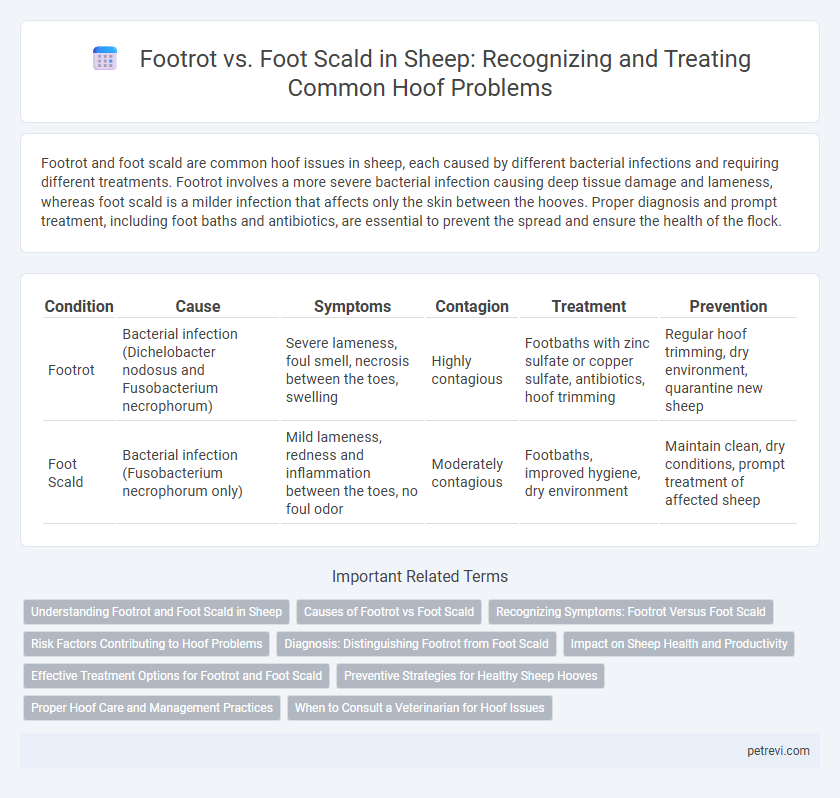Footrot and foot scald are common hoof issues in sheep, each caused by different bacterial infections and requiring different treatments. Footrot involves a more severe bacterial infection causing deep tissue damage and lameness, whereas foot scald is a milder infection that affects only the skin between the hooves. Proper diagnosis and prompt treatment, including foot baths and antibiotics, are essential to prevent the spread and ensure the health of the flock.
Table of Comparison
| Condition | Cause | Symptoms | Contagion | Treatment | Prevention |
|---|---|---|---|---|---|
| Footrot | Bacterial infection (Dichelobacter nodosus and Fusobacterium necrophorum) | Severe lameness, foul smell, necrosis between the toes, swelling | Highly contagious | Footbaths with zinc sulfate or copper sulfate, antibiotics, hoof trimming | Regular hoof trimming, dry environment, quarantine new sheep |
| Foot Scald | Bacterial infection (Fusobacterium necrophorum only) | Mild lameness, redness and inflammation between the toes, no foul odor | Moderately contagious | Footbaths, improved hygiene, dry environment | Maintain clean, dry conditions, prompt treatment of affected sheep |
Understanding Footrot and Foot Scald in Sheep
Footrot and foot scald are common infectious diseases affecting sheep hooves, caused primarily by bacteria such as Dichelobacter nodosus and Fusobacterium necrophorum. Footrot results in severe inflammation and tissue necrosis between the hooves, often leading to lameness, while foot scald is a milder form of interdigital dermatitis characterized by superficial infection and irritation. Early diagnosis and management including proper hygiene, footbathing with zinc sulfate, and targeted antibiotic treatment are crucial in controlling the spread within flocks.
Causes of Footrot vs Foot Scald
Footrot in sheep is caused primarily by the bacteria Dichelobacter nodosus, which invades damaged hoof tissue following environmental conditions such as wet and muddy pastures, leading to severe inflammation and lameness. Foot scald, a less severe condition, results from Fusobacterium necrophorum infecting the interdigital skin, typically in damp, unhygienic environments but without the deeper tissue invasion seen in footrot. Both conditions thrive in moist settings, but footrot requires the presence of virulent Dichelobacter nodosus strains, whereas foot scald arises from more superficial bacterial colonization.
Recognizing Symptoms: Footrot Versus Foot Scald
Footrot in sheep is characterized by severe lameness, swelling between the toes, and a foul-smelling, necrotic lesion causing tissue destruction, while foot scald presents as mild inflammation and moist, reddened skin between the hooves without severe odor or deep tissue damage. Recognizing symptoms such as foul odor and the extent of tissue involvement helps distinguish footrot from foot scald, which is primarily a superficial infection affecting only the interdigital skin. Early identification aids in selecting appropriate treatments to prevent herd-wide spread and minimize productivity losses.
Risk Factors Contributing to Hoof Problems
Poor hygiene and wet, muddy conditions significantly increase the risk of footrot and foot scald in sheep by creating an environment conducive to bacterial growth. Overcrowding in pens and poor drainage exacerbate these conditions, leading to more frequent outbreaks of Dichelobacter nodosus and Fusobacterium necrophorum infections. Nutritional deficiencies, particularly low zinc and biotin levels, weaken hoof integrity, making sheep more susceptible to severe lameness caused by these hoof diseases.
Diagnosis: Distinguishing Footrot from Foot Scald
Footrot in sheep presents with severe inflammation, necrosis, and a foul odor, often causing lameness, whereas foot scald is characterized by mild interdigital dermatitis without deep tissue damage or odor. Diagnosis relies on clinical signs and lesion severity; footrot typically shows separation of the hoof horn at the interdigital skin, while foot scald affects only the superficial skin between the claws. Accurate differentiation is critical for effective treatment, as footrot requires antimicrobial therapy, while foot scald may resolve with improved hygiene and preventive measures.
Impact on Sheep Health and Productivity
Footrot causes severe lameness in sheep, leading to decreased mobility, reduced feed intake, and significant weight loss, ultimately impairing overall productivity. Foot scald, a milder infection affecting the interdigital skin, often precedes footrot and results in moderate discomfort but less severe production losses. Effective management of both conditions is crucial to maintain flock health, prevent chronic infections, and sustain wool quality and growth rates.
Effective Treatment Options for Footrot and Foot Scald
Footrot in sheep requires aggressive treatment with systemic antibiotics such as oxytetracycline or long-acting penicillin combined with topical antiseptic footbaths containing zinc sulfate or copper sulfate for best recovery outcomes. Foot scald, caused by infection of the interdigital skin but without hoof horn separation, typically responds well to frequent hoof trimming and consistent application of zinc sulfate footbaths without necessarily needing antibiotics. Proper isolation of affected animals and maintaining dry, clean environment conditions enhance healing and reduce recurrence rates for both footrot and foot scald in sheep flocks.
Preventive Strategies for Healthy Sheep Hooves
Effective preventive strategies for footrot and foot scald in sheep focus on maintaining clean, dry environments to minimize bacterial growth. Regular hoof trimming combined with footbaths containing zinc sulfate or formalin helps control infection and supports hoof health. Implementing quarantine protocols for new or affected animals reduces disease spread, ensuring healthier hooves across flocks.
Proper Hoof Care and Management Practices
Footrot and foot scald are common sheep hoof issues caused by bacterial infections, with footrot presenting more severe lameness and tissue damage compared to the milder, superficial inflammation of foot scald. Proper hoof care includes regular trimming, maintaining dry, clean environments, and applying topical treatments or antibiotics as necessary to prevent and control infections. Implementing effective biosecurity measures and monitoring flock health can significantly reduce the prevalence of these conditions and improve overall sheep welfare.
When to Consult a Veterinarian for Hoof Issues
Consult a veterinarian for sheep hoof issues if lameness persists beyond 48 hours or if there is severe swelling and foul odor, indicating advanced footrot infection. Early veterinary intervention is crucial to prevent the spread of footrot, a contagious bacterial disease distinguishable from foot scald by its deeper tissue damage and necrosis. Prompt diagnosis and treatment help minimize economic losses and improve animal welfare by managing both footrot and foot scald effectively.
Footrot vs Foot Scald for Sheep Hoof Issues Infographic

 petrevi.com
petrevi.com